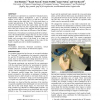Free Online Productivity Tools
i2Speak
i2Symbol
i2OCR
iTex2Img
iWeb2Print
iWeb2Shot
i2Type
iPdf2Split
iPdf2Merge
i2Bopomofo
i2Arabic
i2Style
i2Image
i2PDF
iLatex2Rtf
Sci2ools
CHI
1997
ACM
1997
ACM
Cooperative Bimanual Action
We present an experiment on cooperative bimanual action. Right-handed subjects manipulated a pair of physical objects, a tool and a target object, so that the tool would touch a target on the object (fig. 1). For this task, there is a marked specialization of the hands. Performance is best when the left hand orients the target object and the right hand manipulates the tool, but is significantly reduced when these roles are reversed. This suggests that the right hand operates relative to the frame-of-reference of the left hand. Furthermore, when physical constraints guide the tool placement, this fundamentally changes the type of motor control required. The task is tremendously simplified for both hands, and reversing roles of the hands is no longer an important factor. Thus, specialization of the roles of the hands is significant only for skilled manipulation. Keywords Two-handed interaction, bimanual asymmetry, virtual manipulation, motor control, 3D interaction, haptics.
| Added | 06 Aug 2010 |
| Updated | 06 Aug 2010 |
| Type | Conference |
| Year | 1997 |
| Where | CHI |
| Authors | Ken Hinckley, Randy F. Pausch, Dennis Proffitt, James Patten, Neal F. Kassell |
Comments (0)

